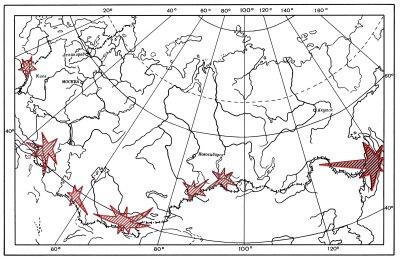 |
QUICK SEARCH
MO PROJECTS:
Africa
Asia/Pacific
Mesoamerica
North America
South America
General Taxonomy
Photo Essays
Training in Latin
America
MO RESEARCH:
Wm. L. Brown Center
Bryology
GIS
Graduate Studies
Research Experiences
for Undergraduates
Imaging Lab
Library
MBG Press
Publications
Climate Change
Catalog Fossil Plants
MO DATABASES:
W³MOST
Image Index
Rare Books
Angiosperm
Phylogeny
Res Botanica
All Databases
INFORMATION:
What's New?
People at MO
Visitor's Guide
Herbarium
Jobs & Fellowships
Symposium
Research Links
Site Map
Search
ORNAMENTAL PLANTS IN THEIR NATURAL HABITATSMain floristic regions Many native plants of the FSU deserve introduction into ornamental horticulture. To search for such plants it is necessary to know: which parts of the country can best be investigated, and which taxa are most promising for use both as ornamentals and in hybridization. The FSU includes several natural zones: Arctic tundra, which occupies 15% of the entire territory; conifer forests, which cover almost half of the territory; deciduous forests, mostly broad-leaved; steppes, and deserts, which are large and occupy about 10% of the FSU. Meadows occur in every floristic zones. The vascular plant flora of the Arctic Islands numbers not more than a few dozen species. In some places of the Central Asian deserts the number of species is 200 with the number climbing in the forest zone to about 1500. On the other hand, there are areas where the vegetation is exceptionally rich, especially endemic ones. Five regions, mostly mountainous, stand out as richest in ornamental species:
According to Takhtajan (1978, 1986), these five regions belong to three Floristic Regions: Circumboreal, Eastern Asiatic, and Irano-Turanian of the Holarctic Kingdom. The aim of this Chapter is to show where, in what environmental conditions, ornamental plants occur. The chance of a lucky transfer increases when a gardener knows the ability of a plant to grow in a new place. A consideration of this will bring up several topics which botanists need to discuss. The first one is a climate comparison, the second one is knowledge of the habitat this particular kind of plant grows in. There are many plants that may grow, within its total range, only in the habitats which are favorable to it. Others live in places where differences in environment is great. These plants are mentioned not once in the text. Usually the members of this last group are easier to introduce. It is important as well to know what other species this particular one is associated with. When a botanist knows the floristic group, and the neighbor species, it can help to choose the place for this plant in new conditions. There are also species that adjusted to one general type, and it is a pretty fair assumption that they have been living together for a long time as a member of the same floristic group. It should be also taken into consideration. In the short description given below more emphasis is given to the territories whose plants have already been tested in botanical gardens and happened to be very good in cultivation, but mostly new to horticulture. Finally, the recommendation of a plant for horticulture should try to take into consideration observations of the plant both in nature and under cultivation. |
|
| ORNAMENTAL PLANTS FROM RUSSIA |
© 1995-2025 Missouri Botanical Garden, All Rights Reserved
4344 Shaw Blvd.
St. Louis, MO 63110
(314) 577-5100
Technical Support
